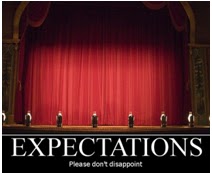Fancy Consultant Jargon
I really enjoy the work I do. I think it is absolutely
vital for your health to love what you do, it also makes for a better end
product. In addition to my full time job, I love the additional opportunity to
not only speak at conferences but also to help a few clients a year through on
site and virtual consulting. I love the work, it is immediately fulfilling to
see an instant impact on an organization and fills the gaps when I'm stuck in
neutral with my own projects sometimes. Out there in the speaking and
consulting world, there seems to be a strange game and the winner is the one
that comes up with the fanciest two dollar word. Well folks, either my
vocabulary has drastically decreased since the SAT or I just don't think jargon
is necessary.
We need to work to eliminate it from our conversations
and keep it in perspective. When we talk about our donors, all who are generous
souls and are complete people, not simply a LYBUNT on a report or a sushi
eating bottom of the pyramid event grenade. So before we endeavor to change our
behavior, let's have a little fun discussing some of the "best" of
the worst I've seen and heard come out of people's mouths lately. If you have
good ones, please share with me and we'll add them to our laugh list. Below are
the terms combined with a real world Lynne definition...tongue firmly implanted
in cheek here :)
- Implementing strategic initiatives- we're actually going to do what we wrote in the plan, not just make it up as we go or settle for "we've always done it that way"
- Maximizing resources- let's try not to spend wads of cash on silly things like paperweights, maybe the best use of our data team's time isn't stuffing envelopes
- Integrated, cross-channel fundraising strategies that are holistic, scalable- let's put together a plan that involves all kinds of donors, not just the big ones at the top of the pyramid, let's talk to them in a variety of ways, let's think about it before we do it...
- Variable data- read this one slowly, Mail Merge, yup, you just paid someone thousands for a fancy mail merge... How about we train, feed, and appreciate our support staff? Maybe we can give them new titles, variable data managers?
- Multi channel integrated approach- we're gonna talk to folks over the phone, in person, through the mail and digitally. All different ways throughout the year. Fancy huh?
- Leverage- your boss has given you permission and you didn't have to beg forgiveness
- Data-driven- let's pull the list before we order quantities? Or perhaps we should actually use the database? Your choice.
- Actionable customer mindsets- aha! Brilliant! Let's ask people what they want before we build an entire program around them. Then once we know what they want, let's do it.
- Feedback mechanism- Survey. Focus group. Asking their opinion. Seriously.
- Move the dial on comprehensive risk-taking- push people to innovate, applaud new ideas and not settle for we've always done it this way. Get boss' buy in... Make sure no one died as a result of new thank you note, Repeat.
- Prism of donor expectations- what do these folks want? Oh, you mean people are different and have different needs? Insert slap head sound and doh! here...
- Key performance measures- we're you successful? Did the good guys win? Have you entered your contact reports? Can you look me in the eye when your direct deposit is posted? Muahaha
- High-water standard- otherwise known as best practices.
- Reorganization- someone's not meeting their key performance measures, let's change the whole division around so we can work around them and they can keep their job, this is nonprofit, we don't fire folks, we just give them new titles like special assistant or advisor... Snarky eh?
- Benchmarking- what is someone else doing that I can steal for the price of a phone call, a glass of wine, a google search, or a well written email? Can you say control find and replace?
In case you haven't had enough ill placed humor, you can
generate your own nonprofit jargon here: http://mysite.verizon.net/grantspeak/
I'd love to hear your thoughts, let the sarcasm and snark
roll here folks.
Cheers,
Lynne














